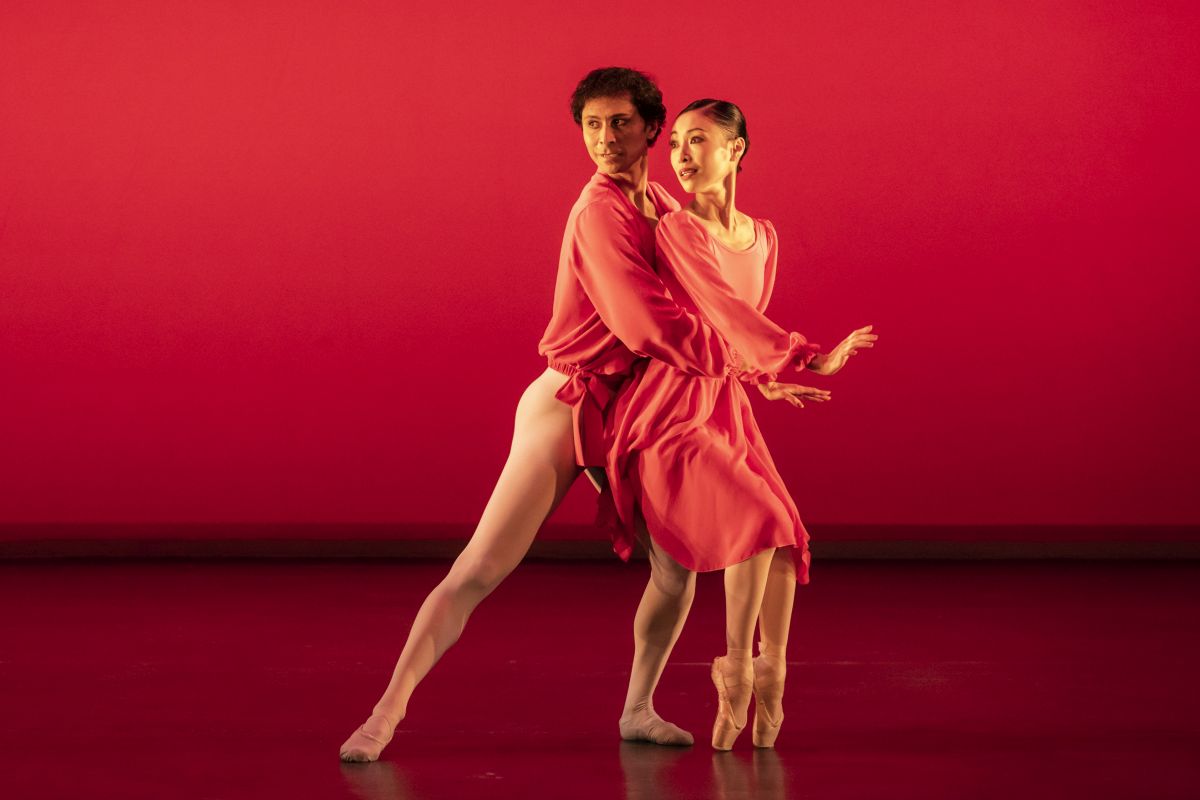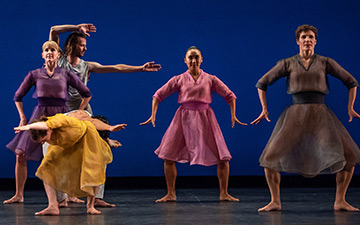
© Johan Persson. (Click image for larger version)
Birmingham Royal Ballet
Lazuli Sky: Our Waltzes, Liebestod, Lazuli Sky
★★★✰✰
London, Sadler’s Wells
Streaming from 1-8 November 2020
29 October 2020
www.brb.org.uk
www.sadlerswells.com
The return of live performances has been like the arrival of spring flowers: uplifting, but undermined by apprehension that frost might nip them in the bud. Ballet companies have been making brave starts, scrupulously observing Covid-19 precautions, but they and their eager audiences are at the mercy of clampdowns to control the spread of the virus. Opening night rejoicing has already proved to be premature in the UK and elsewhere.
Last week, Birmingham Royal Ballet (BRB) re-opened Sadler’s Wells after seven months’ darkness, having first launched its Lazuli Sky triple bill at the Birmingham Rep the week before. The programme is available online for a limited period for those unable to get theatre tickets in reduced auditoria – the Wells was restricted to 30 per cent capacity. The audience of about 400 was enthusiastic, welcomed by Alistair Spalding, on behalf of Sadler’s Wells and Carlos Acosta, BRB’s director. The absence of an interval, however, muted the excited atmosphere. Fifteen minutes of masked mutterings passed before the third ballet, Will Tuckett’s new Lazuli Sky, could take place. The stage had to be disinfected for the next bubble of dancers, making it potentially slippery.

© Johan Persson. (Click image for larger version)
Optimistically, Lazuli Sky is described in BRB’s publicity as ‘a regenerative ballet’. Instead of dwelling on the angst and solitude of lockdown experiences, Tuckett was inspired by nature’s capacity for renewal. He was challenged by requirements for social distancing, coming up with an idea, realised by designer Samuel Wyer, for costumes that keep performers apart. Even once restrictions had been eased with the introduction of social bubbles, grid marks on the floor remain as a reminder of separate spacings.
The music is John Adams’s Shaker Loops, played by a string septet from the Royal Ballet Sinfonia suitably distanced in the pit. The title refers to a religious sect whose members went into an ecstatic physical and spiritual frenzy of worship. The shaking and trembling in the music’s tremolo passages impel the dancers’ agitated motion, giving an impression of nervous tension even as they enjoy being able to perform together once again.

© Johan Persson. (Click image for larger version)
In the early sections, they resemble teams of athletes preparing for a game, then, when they break into smaller groups, like insects skittering across the surface of water. Projections by Nina Dunn and lighting by Peter Teigen change the background from lapis lazuli blue to lush foliage or windswept crags. In the middle section, dancers of both sexes appear in long skirts that flare into flowers, sails, batwings or lizards’ ruffs. Amongst them, scantily clad couples encounter each other in forms of avian courtship, with a central pas de deux for Yu Kurihara and Tom Rogers to a solo cello.
In the speedy concluding section, all 12 dancers dart back and forth in canon formations and rippling circles. There’s a suggestion of a spring sacrifice as a man is ringed by bodies, disappearing in their midst until he is resurrected: the community unites, reaching inwards with outstretched hands. Lazuli Sky is an effective, very theatrical collaboration, using a restricted vocabulary of classical ballet steps with a great many jittery pas de bourrées.

© Johan Persson. (Click image for larger version)
Vicente Nebrada’s Our Waltzes, which opens the programme, overuses waltz steps, or in ballet terminology, lilting balancés. Nebrada (1930-2002) lapsed into clichés that Jerome Robbins deftly avoided in his Dances at a Gathering, made seven years earlier: colour-coded couples, pretty lifts, lots of whirlings about, finishing in embraces that end with dancers sitting or lying on the floor. The five couples don’t appear to acknowledge the on-stage pianist, Jonathan Higgins, playing Latin-infused waltzes by five South American composers.
The principal pair in red, Momoko Hirata and César Morales, are tempestuous; Yaoquian Shang and Mathias Dingman are sweet in pink, Miki Mizutani and Tu-Chao Chou vivid in orange. Samara Downs in lilac mislays her partner, Tyrone Singleton, but finds him again. There’s no insight into relationships, no wit to help dancers define their personalities, however ardently they perform. All ends happily, with no need to keep apart.

© Johan Persson. (Click image for larger version)
In between the two ensemble pieces comes a male solo, Liebestod, choreographed by Valery Panov. A former dancer with the Kirov Ballet, he and his wife were jailed by the Soviet authorities in 1972 for wanting an exit visa for Israel. After an international outcry, they were released and he eventually ended up founding the Panov Ballet Theatre in Israel in 1998, the year he created the solo. Set to Richard Wagner’s music for the final moments of Tristan and Isolde, it’s a portentous Soviet-style athletic musing about life and death.
Brandon Lawrence, one of three BRB principals who dance the role, performs it with heroic conviction, lit by Peter Teigen to reveal every muscle and sinew. Starting from a foetal position, Lawrence unfolds his limbs, discovers his propulsive power as a virtuoso dancer and succumbs to death. An audience-pleasing gala number, its main virtue is to give the company’s men the chance to be appreciated as soloists.

© Johan Persson. (Click image for larger version)
Carlos Acosta, ten months in to his directorship of BRB, has provided it with a mixed bunch of shoots for a fresh start. Their first flowering may have been cut short by the closure of theatres but the company has already shown its resilience, and will do so again. In the meantime, films, videos and streamings of performances will have to suffice, reaching audiences once again confined to our homes.

















You must be logged in to post a comment.